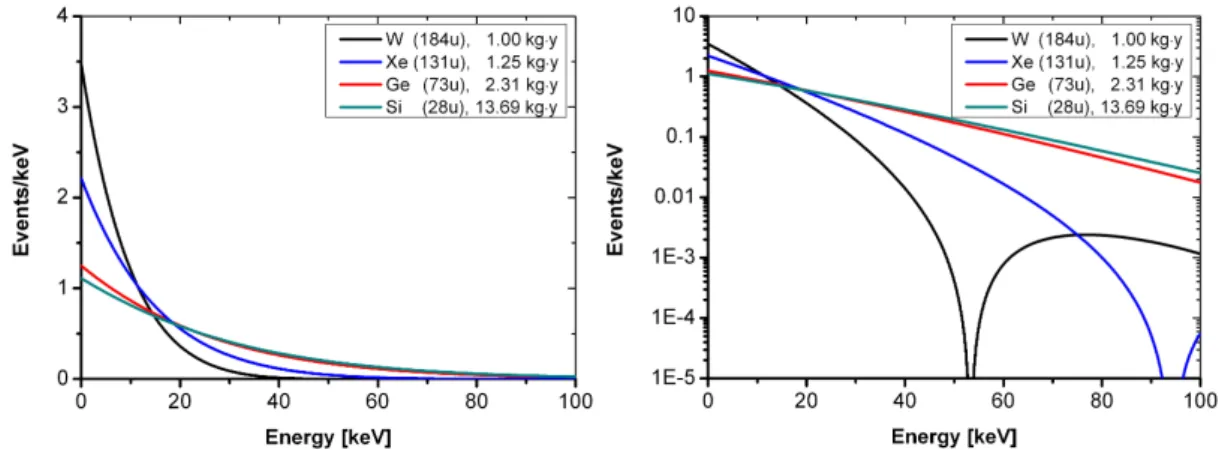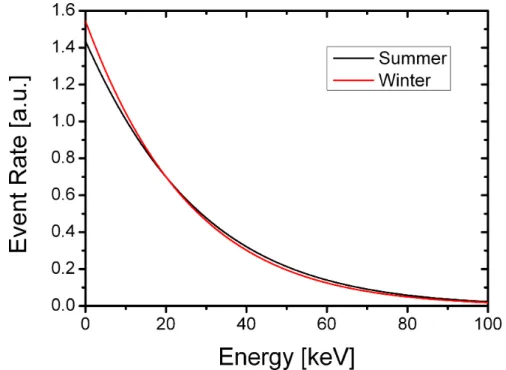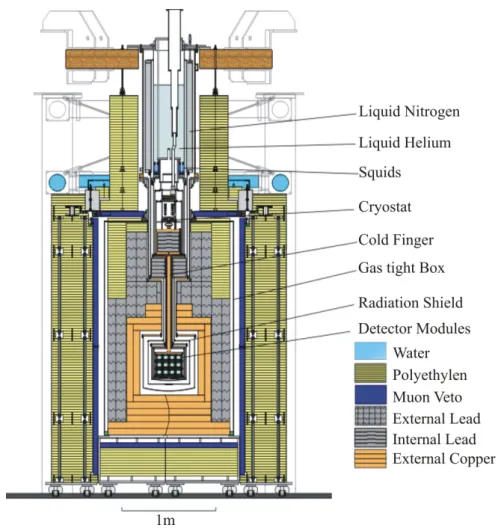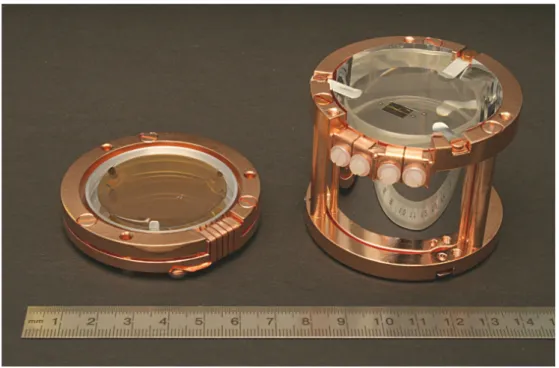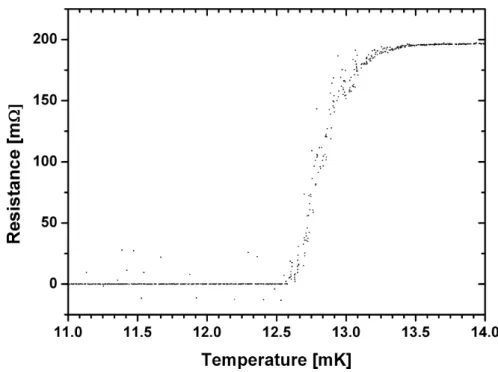Werner-Heisenberg-Institut
The Detector Parameters Determining the Sensitivity of the CRESST-II Experiment
Patrick Hu
March 2010
Dissertation
an der Fakultät für Physik der Technischen Universität München
Max-Planck-Institut für Physik Werner-Heisenberg-Institut
The Detector Parameters Determining the Sensitivity of the CRESST-II Experiment
Patrick Hu
Vollständiger Abdruck der von der Fakultät für Physik der Technischen Universität München zur Erlangung des akademischen Grades eines
Doktors der Naturwissenschaften genehmigten Dissertation
Vorsitzender: Univ. - Prof. Dr. A. Ibarra
Prüfer der Dissertation: 1. Hon. - Prof. A. C. Caldwell, Ph.D.
2. Univ. - Prof. Dr. T. Lachenmaier
Die Dissertation wurde am 08.03.2010 bei der Technischen Universität München eingereicht und durch die Fakultät für Physik am 23.04.2010 angenommen.
Rahmen dieser Arbeit diskutiert und das Verständnis dieser weiter entwickelt.
CRESST-II ist ein Experiment, dass direkt nach Dunkler Materie in Form von WIMPs sucht.
Indirekte Beobachtungen Dunkler Materie wie z.B. Rotationskurven von Gala- xien, welche die grundlegende Motivation für das gesamte Experiment bilden, werden in Abschnitt 1.1 präsentiert. Diese bis heute unverstandenen Beobach- tungen können durch unterschiedliche Erweiterungen des Standardmodells der Teilchenphysik erklärt werden (Abschnitt 1.2). Die von einigen dieser Theorien vorhergesagten WIMPs sind eine der bevorzugten Möglichkeiten, die Natur der Dunklen Materie zu erklären. Möglichkeiten für einen direkten Nachweis dieser Teilchen werden in Abschnitt 1.3 diskutiert.
CRESST-II, welches eines der Experimente ist, das direkt nach WIMPs sucht, wird in Kapitel 2 präsentiert. Ausgehend von der CRESST-II-Funktionsweise, welche in Abschnitt 2.2 beschrieben wird, können die wesentlichen Parameter ver- standen und bestimmt werden, welche die Sensitivität von CRESST-II festlegen (Abschnitt 2.3). Dies sind die sogenannten Quenchingfaktoren und die Energie- auösungen der beiden gemessen Signale.
Die Quenchingfaktoren werden in Kapitel 3 behandelt. Zunächst werden in Ab- schnitt 3.1 aktuelle Daten präsentiert. Im darauf folgenden Abschnitt 3.2 werden diese Werte anhand einer mikroskopischen Erklärung untereinander in Verbin- dung gebracht. Schlüsse und Folgerungen aus dieser Erklärung sind abschlieÿend in Abschnitt 3.3 dargelegt.
In Kapitel 4 werden die Energieauösungen der beiden gemessenen Kanäle dis- kutiert. Die Parameter, welche die gemessene Signalhöhen bestimmen, werden in Abschnitt 4.2 aufgelistet. Abschnitt 4.3 diskutiert hingegen die Parameter, welche im wesentlichen für die Messunsicherheiten verantwortlich sind.
Um den Zusammenhang der physikalischen Abläufen und den physikalischen Ei- genschaften eines Lichtdetektors verstehen zu können, welche wesentlich die Sen- sitivität von CRESST-II beeinussen, wird in Kapitel 5 ein Modell eingeführt und angepasst. Die mathematische Lösung wird in Abschnitt 5.4 präsentiert. Sie wird danach in Abschnitt 5.5 diskutiert und physikalisch interpretiert.
Abschlieÿend befassen sich Kapitel 6 und 7 mit den zuvor bestimmten Parame- tern, welche die Sensitivität des Experiments bestimmen. Einige dieser Parameter werden modiziert, bei anderen werden mögliche Änderungen vorgeschlagen.
ules of the CRESST-II experiment are discussed and the understanding of their behavior is developed in further details. CRESST-II is an experiment searching directly for Dark Matter in the form of WIMPs.
Indirect observations of Dark Matter, e.g. galactic rotation curves, which are the motivation for the experiment, are presented in section 1.1. These up to now unexplained observations can be understood by theories extending the standard model of particle physics (section 1.2). Out of these theories, WIMPs are one of the most favored particles explaining the observations. A direct detection of these particles is discussed in section 1.3.
CRESST-II, as one experiment searching directly for WIMPs, is presented in chapter 2. From the CRESST-II operational principles described in section 2.2, one can understand the main parameters determining the experiment's sensitivity (section 2.3). These are the so-called quenching factors and the energy resolutions of the two measured channels.
The quenching factors are discussed in chapter 3. In this chapter, rst, recent measured data are presented in section 3.1. Afterwards in section 3.2, these data are explained on a microscopic scale. Conclusions and outcome of this explana- tion are discussed in section 3.3.
In chapter 4, the energy resolutions of the two measured channels are discussed.
The parameters which determine the measured signal height are itemized in sec- tion 4.2. In section 4.3, the parameters dominating the measurement uncertainty are discussed.
To be able to understand the connection between the physics in the light detec- tor and its material properties a model is taken and adapted in chapter 5. The mathematical solution of the model is presented in section 5.4, and discussed and physically interpreted in section 5.5.
Finally, in chapter 6 and 7, some of the previously found out parameters which determine the CRESST-II sensitivity are modied and further possible variations are discussed.
1 Dark Matter 1
1.1 Indirect Observations of Dark Matter . . . . 1
1.2 Theoretical Explanations . . . . 6
1.2.1 Dark Matter Properties . . . . 6
1.2.2 Dark Matter Candidates . . . . 6
1.3 Direct Detection of Dark Matter in the Form of WIMPs . . . . . 8
1.3.1 Interaction Rate . . . . 9
1.3.2 Deposited Energy . . . 11
1.3.3 Energy Spectrum . . . 11
1.3.4 WIMP-Signature . . . 14
2 The CRESST-II Experiment 17 2.1 CRESST-II Setup . . . 17
2.1.1 Background Reduction and Identication . . . 17
2.1.2 CRESST-II Detector Modules . . . 22
2.2 CRESST-II Operation . . . 24
2.2.1 Signal Measurement . . . 24
2.2.2 Signal Dierentiation . . . 26
2.3 CRESST-II Sensitivity . . . 29
2.3.1 Light-Phonon-Plane . . . 29
2.3.2 Parameters of the CRESST-II Sensitivity . . . 34
2.4 Motivation of this Work . . . 36
3 Quenching Factors of CaWO4 37 3.1 Quenching Factors . . . 37
3.1.1 Quenching Factor Denition . . . 37
3.1.2 Quenching Factor Measurement for CaWO4 . . . 38
3.2 Quenching Factor Explanation . . . 41
3.2.1 Saturation of the Light Production . . . 41
3.2.2 Linearity of the Light Production . . . 43
3.2.3 Energy Deposition and Light Production . . . 45
3.3 Energy Dependence of the Bands . . . 48
4 Energy Resolution of the Light Channel 51
4.1 Setup of the Light Channel . . . 53
4.1.1 Target Crystal . . . 53
4.1.2 Reecting Housing . . . 55
4.1.3 Light Absorber . . . 55
4.1.4 Thermometer . . . 55
4.2 Mean Measured Energy . . . 56
4.2.1 Energy Transformation: p . . . 58
4.2.2 Photon Transport: q . . . 59
4.2.3 Phonon Transport: r . . . 61
4.2.4 Heat Capacity: CT . . . 63
4.2.5 Transition Slope: m. . . 64
4.2.6 Thermometer Bias Current: IT . . . 66
4.2.7 Shunt Resistance: RS . . . 67
4.2.8 Thermometer Resistance: RT . . . 67
4.2.9 Current to Voltage Transformation: ∂Φ∂U0∂Φ∂I0 . . . 67
4.2.10 Energy Calibration: c. . . 68
4.3 Measurement Uncertainty . . . 69
4.3.1 Energy Transformation: δp . . . 69
4.3.2 Photon Transport: δq. . . 69
4.3.3 Absorbed Energy: δELD . . . 70
4.3.4 Phonon Transport: δr . . . 70
4.3.5 Heat Capacity: δCT . . . 70
4.3.6 Thermometer Temperature Rise: δ ∆TTdep . . . 71
4.3.7 Transition Slope: δm . . . 71
4.3.8 Thermometer Resistance Change: δ(∆RT) . . . 71
4.3.9 SQUID Bias Current Change: δ(∆IS) . . . 73
4.3.10 Summing Up and Conclusions . . . 74
5 Model of the Energy Transport in the Light Detector 77 5.1 Introduction . . . 77
5.2 Model Assumptions . . . 78
5.3 Equations for the Temperatures . . . 81
5.3.1 Basic Equations for the Temperatures . . . 81
5.3.2 Thermometer Heater . . . 83
5.3.3 Bias Current Self-Heating . . . 86
5.3.4 Phonon Collectors . . . 88
5.3.5 Time Duration of the Energy Deposition . . . 90
5.3.6 Equations for the Relative Temperatures . . . 93
5.4 Solution of the Equations . . . 93
5.5 Discussion of the Solution . . . 95
5.5.1 First Case: GAT ≡0 . . . 96
5.5.2 Second Case: GAT G∗BT =GAB . . . 97
5.5.3 Third Case: CT CA &GAB ≡0. . . 99
5.5.4 Summary . . . 101
5.5.5 Fourth Case: Real Light Detector . . . 102
6.1.2 Separated Heater . . . 114
6.2 Discussion of Modications . . . 119
6.2.1 Thermometer Size . . . 119
6.2.2 Maximization of ∆Te . . . 121
7 Conclusions and Perspectives 123 A Heat Capacities 127 B Solution of the Two Coupled Dierential Equations 131 C Practical Remarks 135 C.1 Superconducting Cooling Strip . . . 135
C.2 Destroyed Gold Structure . . . 137
C.3 Thermometer Temperature Increase During a Pulse . . . 138
D Notation 141
Bibliography 144
Dark Matter
Although the nature of more than 95 % of the matter and energy in the universe are unknown, a rough idea of the constitution of our universe is well-established.
It consists mainly of Dark Energy (72.6 %) and Dark Matter (22.8 %). Only about 4.6 % of the total universe density are well-known baryonic matter [1]. The nature of Dark Energy and Dark Matter is unknown.
For Dark Energy up to now no conclusive idea exists, which could explain its nature. For Dark Matter, on the other hand, dierent concrete ideas have been developed, which could explain it (section 1.2). In the next section, some of the most convincing indirect observations of Dark Matter will be presented shortly.
These indirect observations give the motivation for the direct detection of Dark Matter (section 1.3) which many ongoing experiments are aiming for.
1.1 Indirect Observations of Dark Matter
Up to now Dark Matter could only be observed indirectly. Some of these ob- servations are presented in the following. Although they use dierent methods and search on dierent cosmological scales all these observations have the same conclusion:
There is much more Dark Matter than luminous matter in the universe.
Rotation Curves of Spiral Galaxies
The stars of spiral galaxies rotate around their galactic center. If a galaxy con- sisted mainly of the visible stars, the rotation speed on stable Keplerian orbits should bev(r)∼1/√
rfor matter at radial distances beyond the visible stars. In- stead, the rotation speedv(r)is approximately constant for huge radii r. I.e. the outer matter moves faster than the gravitational binding of the visible objects would allow for.
In gure 1.1 such a measured rotation curve of the spiral galaxy M33 is shown (points). The velocity contribution from the stellar disk (short dashed line) to- gether with the gas contribution (long dashed line) cannot explain the measured
Figure 1.1: The radial velocity distribution of spiral galaxy M33 is shown. Measured values of the rotation curve are plotted with points. The velocity contribution from the stellar disk of M33 is shown with the short dashed line, the gas contribution with the long dashed line. Without an additional halo contribution (dashed-dotted line) the measured velocities cannot be explained. Figure taken from [2].
velocities. Only with an additional contribution from a halo (dashed-dotted line), which contains large amounts of Dark Matter, the measurement can be explained [2].
Velocity Dispersions of Dwarf Galaxies and Galaxy Clusters
In galaxy clusters and especially in dwarf galaxies huge amounts of Dark Matter are expected. The reason for this is that the observed matter velocities are unusu- ally large, which are not allowed from the gravitational binding of the luminous matter only [3].
In a gravitationally bound system which is in equilibrium, the virial theorem expects:
2hEKini=−hEP oti
The averaged kinetic energy can be determined by the total massM, the total lu- minosityL, the individual luminositiesli, and the individual peculiar velocitiesvi of the constituent parts of the system:
hEKini=hEKini(M, L, li, vi)
On the other hand, the averaged potential energy depends on the total mass M, the total radius R, and the mass distribution which is described by α:
hEP oti=hEP oti(M, R, α)
Figure 1.2: A picture of the galaxy cluster Abell 2218 from Hubble Space Telescope.
The cluster acts like a lens which distorts background galaxies into long thin arcs around this galaxy cluster. The picture is taken from [5].
Comparing these energies a signicant discrepancy can be seen [4]. The obser- vations can be explained by the presence of a Dark Matter component in the systems largely exceeding the luminous matter content.
Gravitational Lensing
The mass distribution, of for example a galaxy cluster, works like a gravitational lens bending the path of the light. If the mass is perfectly symmetric (e.g. a black hole) and exactly on the line of sight, the light of an object behind the gravitational lens can be seen as a ring. Such a ring is called Einstein ring.
In reality, it happens much more often that only a part of such a ring can be observed. These parts are called arcs.
An example for arcs can be seen in gure 1.2, where a picture of galaxy cluster Abell 2218 is shown. The long arcs are centered around Abell 2218. They are the pictures of mainly the same luminous matter from far behind the galaxy cluster.
From these arcs, the mass distribution of the lensing galaxy cluster can be derived.
Again a huge amount of Dark Matter is necessary in the lensing system to explain the observations, e.g. [6] or [7]. The mass distributions inferred from gravitational lensing are generally in good agreement with the expected Dark Matter amount deduced from other observations.
Temperatures of Gases in Galaxy Clusters
Observations of galaxy clusters show that they contain huge amounts of hot gas that exceed the luminous mass by many times. But still this mass is not enough to explain the observation that, despite its temperature and therefore its kinetic energy, the hot gas is bound in the system. Huge amounts of Dark Matter can explain this phenomenon. By analyzing the gas prole even a prole of the
Figure 1.3: This gure shows the temperature uctuations of the CMB. It provides information about the constitution of the universe. Figure taken from [9].
expected Dark Matter distribution can be derived [8].
Temperature Fluctuations of the CMB
The Cosmic Microwave Background radiation (CMB) is the omnipresent thermal radiation in the universe. Its temperature today is 2.725 K. The measurement of the CMB is not only an indication for the Big Bang theory,1 it provides also an information about the constitution of the universe.
About 400 000 years after the Big Bang photons decoupled from the cosmic plas- ma, which combined to neutral atoms, so from that time on the photons could travel through the universe nearly without interactions. These photons, the CMB, have not been interacting since they decoupled from the ordinary matter. Small temperature uctuations of the CMB therefore reect the density uctuations 13.7 billion years ago, see gure 1.3. The analysis of these uctuations let expect that about 21.4 % of the universe mass are in form of the Dark Matter [9].
Modeling the Universe Structures
Another observation which indicates the existence of Dark Matter, is the overall distribution of the visible matter in our universe. The observed matter distri- bution can be compared with results of simulations. If they do not t, then the assumption of the simulation cannot be right; if they t, then the assumptions are maybe correct.
In general, simulations of the evolution of the universe begin about 400 000 years
1The main two other observations suggesting the Big Bang theory are Hubble's law, i.e. the ex- pansion of space and the primordial nucleosynthesis, i.e. the mechanism which explains today's abundance of the light elements in the universe.
Figure 1.4: Four dierent points in time of the Millennium Simulation [10]. The rst picture on the top left is at t = 0.21Gyr after the Big Bang. The second one on the top right is at t = 1.0Gyr. The one on the bottom left is at t = 4.7Gyr and the last picture on the bottom right is today att= 13.6Gyr.
after the Big Bang. At that time the universe got transparent for photons. Only small uctuations in the density prole are assumed. Simulations starting at that time without Dark Matter cannot reproduce the matter distribution observed to- day; but with Dark Matter included the simulations t well. The reason for this is that Dark Matter clumps together earlier than baryonic matter, since it is not kept apart from each other by the electromagnetic radiation. Only with this earlier formation of the Dark Matter the universe can develop to the observed matter distribution of today.
One simulation supporting this is the so-called Millennium Simulation. Four dif- ferent points in time of this simulation can be seen in gure 1.4. The simulation starts 300 000 years after the Big Bang with a nearly homogeneous Dark Mat- ter distribution. It ends with a matter distribution similar to the one observed today [11].
The simulations of the evolution of the universe show that with the existence of a signicant amount of Dark Matter the observed structures of the universe can be explained.
1.2 Theoretical Explanations
As seen above, observations indicate a huge amount of Dark Matter in our uni- verse. These independent measurements suggest that about 23 % of the universe consists of Dark Matter. That is ve times more than the known matter and more than 50 times more than the luminous matter.
In the following dierent theoretical explanations will be introduced. In sec- tion 1.2.1 properties which Dark Matter candidates have to fulll to be consis- tent with the observations will be specied. Afterwards, in section 1.2.2, dierent motivated candidates which have these properties will be presented.
1.2.1 Dark Matter Properties
Assume that Dark Matter consists mainly of one component. Then this compo- nent has to fulll dierent properties, which follow from the indirect Dark Matter observations. Consequently, a well motivated candidate for Dark Matter should be able to fulll the properties which are itemized in the following:
It should be electrically neutral, otherwise it could emit or absorb light and would not be dark. It should be color neutral, not to interact strongly, and moreover it should interact gravitationally. On the contrary, for the weak interaction there is no constraint. A participation in the weak interaction is possible but not necessary. If Dark Matter interacts weakly, this can open the possibility for a direct detection.
It should provide the correct relic abundance. Firstly, this means that it has to be stable at least on a cosmological time scale, since it existed at the beginning of the universe (structure formation, CMB) and is still observ- able (rotation curves, gravitational lensing). Secondly, assuming a spherical isothermal Dark Matter halo enclosing our galaxy, it should provide a local Dark Matter density of 0.2 - 0.4 GeV/cm3 today [12].
It should be non-relativistic at the time of structure formation, i.e. Cold Dark Matter:2 Cold Dark Matter builds up small structures, whereas Hot Dark Matter builds up large structures. Simulations show that the structure formation can only yield the observed mass distribution of today when small structures form rst. This is called bottom-up structure formation.
Therefor a huge amount of Cold Dark Matter is necessary.
It should nally not be excluded by any experiment.
1.2.2 Dark Matter Candidates
In this section some of the most developed and motivated Dark Matter candidates will be presented. They all fulll the properties listed above. Whether one of these candidates is the right one could not be claried up to now.
2Relativistic dark matter at that time is called Hot Dark Matter.
Out of the known particles, which are united in the standard model of particle physics, the neutrino is the only possible candidate for Dark Matter, since it is electrically and color neutral. The neutrino also takes part in the gravitational interaction and it is stable. However, from the known upper neutrino mass and density limits one can derive that their total mass is much too small to provide a signicant contribution to Dark Matter [13]:
0.5 %< Ων <1.5 %
Also the theory of structure formation contradicts neutrinos being a signicant amount of Dark Matter. Since neutrinos were relativistic at the time of structure formation they contribute to Hot Dark Matter. This supports the top-down structure formation, which cannot be supported by observations.
Out of this can be concluded:3
The existence of Dark Matter is evidence for
new physics beyond the standard model of particle physics.
The standard model particles cannot explain the Dark Matter observations. How- ever, there exist many dierent theories, which extend the standard model. And still many of these theories exist, which let expect new, stable, but up to now un- observed particles. Some of these particles are proper candidates for building up Dark Matter. For example the Little Higgs Model [14] or the KaluzaKlein theory [15] can predict such particles. Also primordial black holes [16] or very light axions (µeV - meV) [17] could be the main contribution of Dark Mat- ter. Theories like these predict particles, which could explain the nature of the indirect observed Dark Matter.
However, the most developed extension, which provides such a particle, is Su- persymmetry. One of the properties of this theory is, that each particle of the standard model has a superpartner. The superpartner of a boson is a fermion and vice-versa. Additionally in this theory each particle of the standard model has an R-parity of +1 and each supersymmetric particle has an R-parity of -1.
If the R-parity in Supersymmetry is conserved, then the lightest supersymmetric particle has to be stable. In this way at least one stable particle can be expected.
It would still exist today and is hence a good candidate for Dark Matter. This should be the lightest particle, which is called LSP (lightest supersymmetric par- ticle). In principle three particles predicted by Supersymmetry are candidates for Dark Matter as the LSP, since they are electrically and color neutral but interact gravitationally: The sneutrino, the neutralino and the gravitino. However, at least in the minimal supersymmetric standard model (MSSM) the sneutrino seems to be ruled out because of the width of the Z-boson decay at LEP [18].
3From the measuredZ0 decay it is known that up tomZ0/2 ≈45GeV/c2 only three neutrino families exist. However, if a heavier fourth neutrino exists, it is not expected to build up Dark Matter, since the abundance is estimated to be too small.
The neutralino would have properties like a heavy neutrino. Its lower mass limit is mχ > 45GeV/c2 [13] and it is a superposition of the wino, the bino, and the uncharged higgsinos. The gravitino is also a candidate for Dark matter. However, since the gravitation is very weak and the gravitino interacts only gravitationally, it seems not to be directly detectable.
As the neutralino in Supersymmetry, many other theories predict a weakly in- teracting massive particle as candidate for Dark Matter. All these particles are summarized in the expression WIMP. It stands for a hypothetical particle which could solve the Dark Matter problem. In the following, WIMPs will be indicated with the neutralino symbol χ.
Up to now, out of all Dark Matter candidates, a WIMP seems to have the best chances of being detectable. Therefore, nearly all direct detection experiments try to realize this idea.
Most direct Dark Matter experiments aim to detect WIMPs.
In the next section the principle of a direct detection of WIMPs will be explained.
From that dierent properties can be derived, which such Dark Matter experi- ments have to consider.
1.3 Direct Detection of Dark Matter in the Form of WIMPs
In section 1.1 we have seen many independent observations of Dark Matter. Also dierent theoretical explanations for these observations are already developed (section 1.2). Out of that, the direct detection possibility which seems to be most promising up to now is the search for WIMPs. Therefore, in this section, cornerstones for this kind of direct Dark Matter detection will be developed.
If the main contribution to Dark Matter are WIMPs, then these weakly inter- acting massive particles will be bound gravitationally in galaxies and galaxy clusters. The simplest assumption is a spherical isothermal halo around the luminous system which is lled with WIMPs. The dimension of such a halo has to exceed the luminous size by many times since the measured rotation curves show constant high velocities still far outside of the luminous masses. Due to the fact that WIMPs do not interact electro magnetically or strongly they can y through the earth, sun, and galaxy nearly without any interaction. They interact even less than neutrinos and are simply bound gravitationally to the system.
However, from time to time, a weak interaction between a WIMP and the bary- onic matter can occur. With typical velocities below the galactic escape velocity WIMPs should scatter coherently and elastically o nuclei. Via these scat- terings energy can be transferred onto nuclei. The detection and identication of these nuclear recoils would be a proof of the WIMP hypothesis.4
4For simplication only the coherent WIMP scattering is considered in this work.
1.3.1 Interaction Rate
To see whether a direct detection of WIMPs is realistic the rate of expected WIMP interactions can be estimated:
In general the detections Rper time and detector target massMT is given by the WIMP ux Φχ through the detector target, the number of target nuclei NT, and their interaction cross section σ:
R = Φχ·NT ·σ
MT = Φχ·σ
mT (1.1)
mT is the mass of one target nucleus.
In the following, the WIMP ux and the cross section will be estimated to get an idea about a possible rate of WIMP interactions:
To evaluate roughly the WIMP ux through a detector target the local WIMP number densitynχand their average velocityv relative to the target have to be known:
Φχ =nχ·v
The local WIMP number density nχ can be derived from the measured Milky Way rotation curve. As mentioned above, the local Dark Matter mass density ρχ at the position of the earth is estimated to be about 0.3 GeV/c2cm3. Thus, assuming the WIMP mass mχ to be 100 GeV/c2, then about 3 000 WIMPs will be in each cubic meter:5
nχ = ρχ
mχ ≈ 0.3GeV/c2cm3
100GeV/c2 = 3 000m−3
Assuming that WIMPs are at rest relative to the galactic frame and the detector target is moving through them with the velocity of the sun v. Then the average WIMP to target velocity is v ≈ v ≈ 220km/s [12]
leading to a WIMP ux of
Φχ≈3 000/m3·220km/s≈65 000cm−2s−1
Considering now that the WIMPs have velocities not much faster than the sun velocity [12], the WIMP ux through the detector stays in the same order of magnitude.
If the assumptions made above are approximately correct, many ten thou- sands of WIMPs will y through the size of a thumbnail every second.
After the WIMP ux the next parameter for the rate estimation of equa- tion (1.1) is the interaction cross section σ. The cross section depends on the two particles and the type of interaction. However, to be able to compare dierent Dark Matter experiments which have all dierent cross
5Assuming each kg of the human body has a volume of one liter, since humans consists mainly of water, then in each kg of mass there are, on average, three WIMPs. Thus, in the volume of a 50 kg human there are about 150 WIMPs.
sections due to the dierent target materials used, a normalized cross sec- tion σnorm is usually introduced to separate the inuence of the specic nuclei [19]:
σnorm = 1 + mmχ
T
1 + mmχ
p
!2
σ A2 ≈
mT mχ + 1
2
σ
A4 (1.2)
≈
σ
A4 for mT mχ mp
mχ 2
σ
A2 for mT mχ A is the atomic mass number and mp is the proton mass.
With this normalization the inuence of the dierent target materials on the cross section for the coherent elastic scattering is taken into account.
The normalized cross section is the value which dierent Dark Matter ex- periments can compare.
Assuming mT = mχ = 100GeV/c2, then A is about 107 and, using the largest possible cross section which is experimentally not excluded up to now σnorm <10−7pb:
σ ≈3.2·107·σnorm .3.2pb
If all these assumptions are roughly correct, the interaction rate of WIMPs with a detector target can be estimated. The detections of equation (1.1) per kilogram detector target and per year is given as:
R.50 1 kg a
Only a few ten WIMP interaction events can be expected for measuring one year with a detector of one kilogram of target mass. A possible, but very dicult challenge due to the usually large number of background events.
Only from this number of expected events it is clear that all possible external background events have to be suppressed as much as possible. This is usually done by using a laboratory deep underground and dierent shieldings. And it is clear that also internal background sources in the shieldings and detectors have to be reduced as much as possible. Nevertheless, the passive background suppression is usually by far not enough. An additional active background suppression is necessary. An identication of background events which could not be suppressed is needed. With such a low background experiment it could be possible to identify a WIMP signal.
An identication of WIMP interactions could be possible, but an extremely low background experiment is necessary for that.
1.3.2 Deposited Energy
Beside the interaction rate the amount of energy Edep transferred, and therefore deposited in the target is an important property for the direct WIMP detection.
An energy transfer via elastic scattering depends mainly on the masses of the two particle and on their velocities.
The WIMP mass in dierent models is expected to be in the range of 45 GeV/c2 to 3 TeV/c2 [13][12]. To visualize possible WIMP masses one can compare them to known baryonic masses. One atomic mass unit u is about one GeV/c2. Lead atoms as one of the heaviest, stable nuclei have a mass of about 195 GeV/c2 and titanium for example has an atomic mass of about 45 GeV/c2. The amount of transferred energy is maximal, when the masses of WIMP and target nucleus match.
The velocities can be estimated simply: The kinetic energy of a target nucleus is zero in the lab frame, whereas the average velocity of WIMPs can be approx- imated from the velocity distribution of the luminous matter in our galaxy. As above the average WIMP velocity is taken to be equal to the velocity of the sun v=vχ = 220km/s.
If WIMPs have a mass of mT = 100GeV/c2 then the kinetic energy of a WIMP is typically:
Eχ= 1
2mχv2χ≈50keV
The energy transfer cannot be larger than the total kinetic energy of the WIMP.
The maximum energy transfer in this case of 50 keV, is only possible for equal masses and head on collisions. Although WIMPs are maybe heavier and there exist higher WIMP velocities, in general the transferred energy will be lower due to the scattering angle.
The amount of energy which has to be detected is of the order of 10 keV.
1.3.3 Energy Spectrum
If Dark Matter consists mainly of WIMPs, a direct detection has the two main properties shown above: A rough estimation of the transferred energy is of the order of 10 keV. The expected rate was evaluated to be not more than about a few ten events per target kilogram and year.6 In this section, a more precise analysis of the expected energy dependent rate will be given.
If WIMPs interact with baryonic matter via coherent elastic scatterings, then these nuclei will receive energy. The amount of energy depends on dierent
6The cross section is assumed to beσnorm<10−7pb and the WIMP mass and the target nuclei mass to bemχ =mT = 100GeV/c2.
parameters. These are the two masses, the velocity of the incident particle, the scattering angle, and the form factor of the nucleus. For the interaction rate R, which depends on the deposited energy Edep, additionally the target mass, the WIMP density and the cross section have to be taken into account.
In this section, rst a simplied but already proper case of the energy spectrum will be presented. In this case one can see nicely from the formula how the dependencies on the various parameters are. Afterwards, a more realistic case will be shown. For this case the resulting formulas will be plotted to show nally, on the basis of the plot, that it does not dier much from the simplied case.
The dependencies are nearly the same.
In the simplied rst case the WIMP velocity distribution is assumed to be Maxwellian without a cut o velocity. In reality the cut o velocity is the escape velocity of the galaxy. WIMPs faster than this velocity are not bound in the galaxy. Hence their density in the galaxy is negligible.
However, this eect is neglected in the rst simplied case. The motions of sun and earth are not taken into account, too. In this case the energy dependent interaction rate can be written as [12]:
dR
dEdep = 2σ0ρχ
π vχmχµ2 ·F2(Edep)·exp
−2mT Edep π µ2vχ2
(1.3) µ is the reduced mass:
µ:= mT ·mχ mT +mχ
σ0 is the interaction cross section for zero momentum transfer and F(Edep) is the form factor, which describes the mass distribution inside the target nuclei.
The energy dependent interaction rate per energy bin is the shape of the expected target nuclei recoil spectrum. It is given mainly by the form factor of the target nuclei and the characteristic exponential decrease.7 For light elements the form factor is nearly constant F2(Edep)≈1; thus the recoil spectrum is roughly an exponential spectrum.
Considering additionally the motions of sun and earth, the WIMP velocity has to be boosted into the earth's rest frame. For this calculation the velocity of the earth, which is equal to the detector target velocity, can be written as [12]:
vT =v
1.05 + 0.07cos
2π(t−t0) 1yr
(1.4) Here, t0 = June 2nd±1.3days, the time when the earth has the highest relative velocity to the WIMP halo. v ≈ 220km/s is the velocity of the
7The exponential decrease is given through the velocity distribution of the WIMPs.
sun in the galactic rest frame.
Taking into account that WIMPs with velocities higher than the escape velocity of the galaxy vesc are not bound in the system, the Maxwellian WIMP velocity distribution has to be truncated. The escape velocity is expected to bevesc = 550±100km/s [20] and is here taken as 650 km/s.
The recoil energy spectrum can then be written as [21]:8
dR
dEdep = σ0ρχ
4vT mχµ2 ·F2(Edep)·
1 2
¯ vmin+¯vT
R
¯ vmin−¯vT
e−τ2dτ −¯vTe−¯vesc2
¯ vesc
R
0
τ2e−τ2dτ
(1.5)
The velocities ¯vx are dened relative to the sun velocity v:
¯
vx := vx
v
vmin is dened as:
vmin =vmin(Edep) :=
s
EdepmT 2µ2
The form factor F(Edep) describes the mass distribution in the target nu- cleus. Conventionally, the so-called Helm form factor, which was introduced by R. Helm [22], is used:
F(Edep) = 3j1(r0Edep) r0Edep e−
s2Edep2 2
j1(Edepr0) is the rst Bessel function, which is responsible for the typical form factor shape, see below. s is the nucleus surface thickness. r0 is the radius of the nucleus. Here, a parametrization of the nucleus is taken from [23].
The denominator in equation (1.5)Rv¯esc
0 τ2e−τ2dτ is the normalization factor of the Maxwellian velocity distribution.
Finally, the contribution −v¯Te−¯vesc2 in equation (1.5) reects the WIMP cut-o velocity.
In gure 1.5 the energy dependent recoil spectrum of equation (1.5) is plot- ted for four dierent targets. The WIMP mass is assumed to be mχ = 100GeV/c2, the cross section to be σnorm = 10−7pb. The dierent expo- sures are chosen so that the total interaction rate is in all cases identical.
In the rst plot the y-axis is linear, in the second logarithmic.
The linear plot shows nicely the exponential decrease of the expected
8The equation is valid for0.13mT .mχ .6.7mT.
Figure 1.5: The energy spectra of equation (1.5) are plotted for four dierent targets.
The WIMP mass is assumed to be mχ = 100GeV/c2, the cross section to be σnorm = 10−7pb. The exposures are chosen so that the total rate is always the same. In the rst plot the y-axis is linear. Here the exponential decrease can be seen nicely. In the second plot the y-axis is logarithmic. In this plot, the inuence of the form factor, which is dominated by the Bessel function, can be seen, in particular for heavy target nuclei.
WIMP interaction rate. In the logarithmic plot the inuence of the form factor is visible, especially for heavy target nuclei. The form factor sup- presses for heavy target nuclei the larger energy transfers due to the Bessel function. It can be seen from the exposure that heavier target nuclei result in higher expected interaction rates.
From both descriptions, the simplied one with equation (1.3) and the more complex one with equation (1.5), the following can be seen:
The recoil energy spectrum is mainly a multiplication of an exponential decrease and the nuclear form factor.
Dark Matter experiments entail the need of being able to detect a small number of nuclear recoils with energies of about 10 keV or even less. Additionally, the expected recoil spectrum is similar to energy spectra due to background events.
Therefore, one of the main challenges is the possibility to avoid and identify background events. This will be discussed in chapter 2. How a WIMP signal could, nevertheless, be identied and distinguished from background signals will be discussed in the following section.
1.3.4 WIMP-Signature
For a Dark Matter experiment it is not enough to simply count events at about 10 keV, since also background events can be measured. Thus it is not possible to identify Dark Matter in the form of WIMPs only from an event rate at low energies. Furthermore, dierent background sources can induce events with an
exponential energy spectrum, too, so that also a measured exponential energy spectrum is not enough. A more characteristic signature is necessary to identify WIMPs clearly. How can such a signature look like? Up to now three possible signatures have been established:
A convenient signature is the measurement and comparison of the interac- tion rates with at least two dierent nuclei. The two nuclei interaction rates can be measured within one or two dierent experiments. With the known sensitive energy range of the experiment, the expected rate can be determined with the help of gure 1.5. Since rates dier for dierent nuclei in a known way, see equation (1.2), Dark Matter could be identied by comparison of the two results.
The second signature is more dicult since it has a drawback. It needs not only a very low background rate, but also a large number of detected WIMP interactions. It is based on the fact that the relative velocity of the earth to the WIMP halo depends on the seasons. In summer, the relative velocity is the highest and in winter the lowest, cp. equation (1.4). Therefore, in equation (1.5), the energy dependent rate changes. In gure 1.6 such a summer-winter modulation is shown. It can be seen that the eect is in the percent range.9 Therefore large statistics is needed to conrm the modulation.
The third signature could be realized on the basis of the identication of the WIMP direction. Since sun and WIMPs have similar velocities, the WIMP ux should come in average preferred from one direction through the detector. If a detector existed, which is able to identify the direction of nuclear recoils and thus the direction of the incident WIMP, WIMPs could be identied. The WIMP ux direction changes from day to night due to the earth's rotation. To check if the signal coming from one direction is extraterrestrial or earth-based, the detector could be turned. Unfortunately, a large enough detector with directional sensitivity could not be realized up to now.
In all these cases a statistically relevant number of WIMP scatterings is necessary.
Such statistics can be achieved via a large target mass, a long measurement duration, and a low WIMP identication threshold. The WIMP identica- tion threshold is dened as the transferred energy below which a WIMP signature cannot be observed any more in a specic experiment. These three parameters, which determine the sensitivity of a Dark Matter experiment, will be discussed in chapter 2.3.2.
Up to now, experiments are limited in all these three possibilities to increase the statistics by background events. Therefore, beside the WIMP scattering rate,
9The modulation depends on the WIMP and target masses and is also sensitive to the halo model.
Figure 1.6: Energy spectra of 100 GeV/c2 WIMPs detected with a germanium target (AGe = 72.6 u) in summer and winter. The dierent shapes result from the change in the relative velocity between earth and WIMP halo. The relative velocity is the highest in summer. Therefore, slightly higher energy transfers are expected. In winter it is the other way round. The relative spectra are computed using formulas (1.4) and (1.5).
the most critical point of a Dark Matter experiment is the background event rate.
There will always be a rate of unidentied background events caused by one or more sources. This rate is a value per time and mass. If the number of back- ground events is much higher than the WIMP signal, an increase of the detector target mass or a prolongation of the measurement duration cannot enable the WIMP detection. Therefore, an identication of the events or a suppression of the background source is necessary.
Also the WIMP identication threshold is limited due to background events.
It is dened on the basis of these events. Below the WIMP identication thresh- old a WIMP signal cannot be measured, since the rate of background events is much higher than the WIMP interaction rate. A lowering of the WIMP identi- cation threshold and therefore an improvement of the experiment's sensitivity can be achieved via a better identication of background events.
The statistics for a direct WIMP detection is limited by background events.
In the next section, a limitation for the WIMP detection due to background events will be discussed for a concrete direct Dark Matter experiment. This will be the (Cryogenic Rare Event Search with Superconducting Thermometers) CRESST-II Dark Matter experiment.
The CRESST-II Experiment
The CRESST-II experiment tries to detect Dark Matter in form of WIMPs. In this chapter CRESST-II will be introduced. First, its setup will be presented in section 2.1. Afterwards, the mode of operation will be explained in section 2.2.
Section 2.3 comes back to the cornerstones of the direct WIMP detection of section 1.3.4, which determine the sensitivity and which will be discussed for the CRESST-II experiment. Finally, out of this discussion the motivation and goal of this work will be presented in section 2.4.
2.1 CRESST-II Setup
As all direct Dark Matter search experiments trying to detect WIMPs, two major challenges exist for CRESST-II: Firstly, to detect low energetic single interactions with a rate of not more than about ten interactions per kilogram of target material and year, and secondly to reduce and identify background events.
The principle of background reduction and identication in CRESST-II will be presented in section 2.1.1. The detector modules, which are able to detect single interactions with energy transfers of even less than one keV, will be introduced in section 2.1.2.
In gure 2.1 the setup of CRESST-II is shown. The detector modules can be seen in central position. They are surrounded by dierent layers of shielding. On the top, the cryostat can be seen, which provides the required low temperature conditions for the detector modules.
2.1.1 Background Reduction and Identication
As mentioned in the rst chapter, background events are the most crucial point for a direct Dark Matter search experiment. Reasons for this are that the background itself is unknown, which prevents a simple subtraction, and that the scattering rate of WIMPs is very low. Therefore most eort of Dark Matter experiments is done in order to reduce and identify background events.
Reduction can be achieved via removing background sources and via the installation of shieldings, which protect the detectors. The identication
Figure 2.1: In this schematic drawing the CRESST-II setup can be seen. Dierent layers of shielding enclose the very center. These are, from the outside, water, polyethy- lene, the muon veto, lead, and copper. On the top of the experiment the longish cryostat can be seen. It provides the low temperature, which is required for detector operation.
The cryostat is thermally connected via a copper post, called cold nger, to the detector modules. They are located in the very center enclosed by the shieldings.
of background events is based on the dierences in the interaction between WIMPs and background.
Reduction of background can be achieved by removing sources, suppressing background interactions,
and identifying background events.
In the following these three possibilities will be explained in more detail.
Reduction of Background Sources
The best way to prevent background events is to remove the source. Removable background sources are in the material volumes, on their surfaces or in the surrounding gas.
Volume: To prevent sources in the volume special radio-pure materials are used. The closer the material is to the detector, the less radioactive it should be.
For the shielding around the detector, for example, roman lead is preferred due to the large proton number and the low intrinsic activity. Generally, in lead the intrinsic activity is dominated by210Pb. In case of roman lead, on the other hand, the material has not been in contact with the other isotopes of the radium series (also called uranium series) for many years. Hence, a further 210Pb production is suppressed eciently and the existing 210Pb nuclei isotopes have decayed with a life time of 138 d. Another possibility for a reduced intrinsic volume activity of a material is the underground storage. This is ecient in case of dominant activation due to the cosmic radiation, as it is the case, for example, for copper.
For this reason in CRESST-II copper is stored in an underground lab.
Surfaces: Typically background sources are most often found on surfaces.
Therefore, if possible, all surfaces should be cleaned mechanically and chem- ically. The material should then not be touched anymore with other radioactive matter. Human sweat, for example, contains the beta emitter 40K. Hence, bare hands should not touch inner materials. In general the storage of the materials in a clean room should be favored.
Surrounding Gas: Also in the surrounding gas there are dangerous back- ground sources. Rock, for example, emits 222Rn, which is radioactive. Therefore, CRESST-II uses an air tight box which surrounds the detectors. An overpressure of radio-pure nitrogen is maintained in this box to prevent radon close to the de- tectors. Materials should hence be surrounded by non-radioactive gases under overpressure.
Passive Background Reduction
Since not all background sources can be removed, the next step for the reduction of unwanted background events is the protection of the detectors by shieldings.
For almost each kind of source, there exists a special shielding. From outside these are in CRESST-II the following:
First, to reduce background events induced by cosmic radiation or their sec- ondary products, Dark Matter experiments are usually located in a deep under- ground lab. The CRESST-II experiment is located in the Laboratori Nazionali del Gran Sasso (LNGS), a lab in the center of Italy placed in a highway tunnel of the Gran Sasso mountains. The protecting rock there is at least 1 400 m thick, which is equivalent to a water depth of about 3 150 m. In that deepness cosmic radia- tion induced events are almost gone. The amount of muons is reduced by about six orders of magnitude to a ux of about 1/h m2 [24]. Not suppressed are only neutrinos, whose energy transfers onto nuclei should be of less than 1 keV [25].
The second protection reduces electro-magnetic interferences. In CRESST-II highly sensitive electronics is used which can be inuenced by electro-magnetic interferences. For this reason a protection by a faraday cage is necessary which encloses and protects the experimental setup.
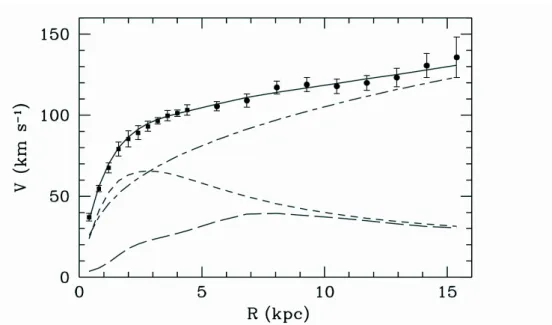
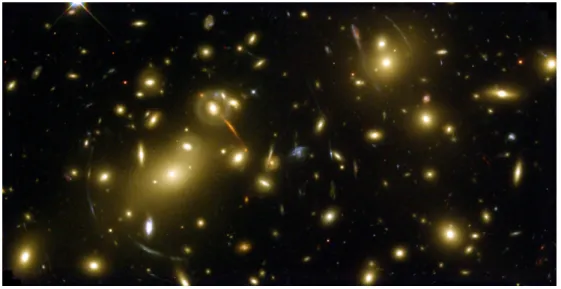
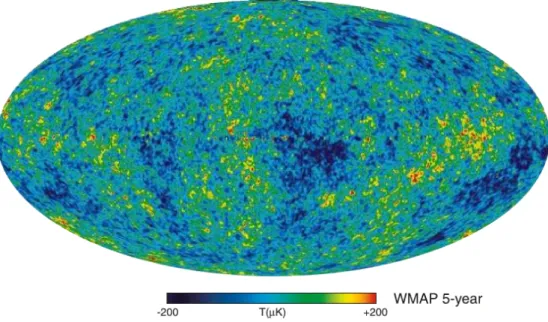
![Figure 1.4: Four dierent points in time of the Millennium Simulation [10]. The rst picture on the top left is at t = 0.21 Gyr after the Big Bang](https://thumb-eu.123doks.com/thumbv2/1library_info/4015115.1541358/15.892.175.786.160.618/figure-dierent-points-time-millennium-simulation-picture-bang.webp)
